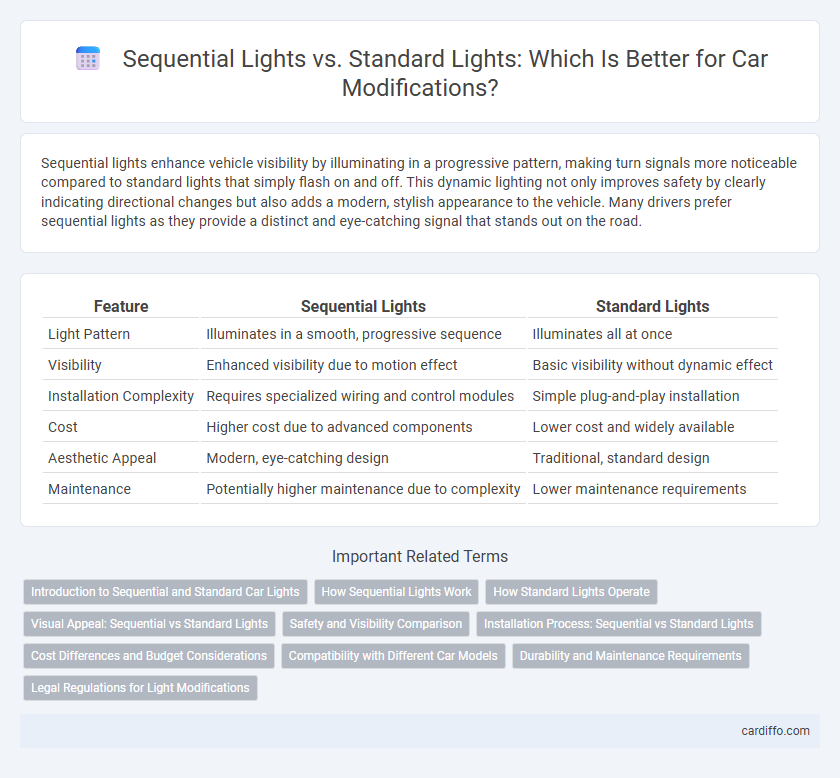Sequential lights enhance vehicle visibility by illuminating in a progressive pattern, making turn signals more noticeable compared to standard lights that simply flash on and off. This dynamic lighting not only improves safety by clearly indicating directional changes but also adds a modern, stylish appearance to the vehicle. Many drivers prefer sequential lights as they provide a distinct and eye-catching signal that stands out on the road.
Table of Comparison
| Feature | Sequential Lights | Standard Lights |
|---|---|---|
| Light Pattern | Illuminates in a smooth, progressive sequence | Illuminates all at once |
| Visibility | Enhanced visibility due to motion effect | Basic visibility without dynamic effect |
| Installation Complexity | Requires specialized wiring and control modules | Simple plug-and-play installation |
| Cost | Higher cost due to advanced components | Lower cost and widely available |
| Aesthetic Appeal | Modern, eye-catching design | Traditional, standard design |
| Maintenance | Potentially higher maintenance due to complexity | Lower maintenance requirements |
Introduction to Sequential and Standard Car Lights
Sequential car lights enhance vehicle signaling by illuminating LEDs in a flowing sequence, improving visibility and communication to other drivers. Standard lights use static illumination, turning on all light segments simultaneously for basic signaling functions. The sequential lighting technology is increasingly adopted in modern cars for its dynamic appearance and clearer indication of turning intentions.
How Sequential Lights Work
Sequential lights operate by illuminating LEDs in a timed sequence, creating a flowing or chasing effect along the light strip. These lights use a microcontroller or integrated circuit to control the precise timing and order of illumination, enhancing visibility and aesthetic appeal. This technology improves signaling clarity by directing attention in a clear, progressive pattern compared to standard static lights.
How Standard Lights Operate
Standard lights operate by receiving a continuous electrical current that powers all bulbs simultaneously, resulting in a steady or blinking illumination without variation in individual light control. The wiring setup for standard lights is typically simpler, with bulbs connected in parallel circuits to ensure consistent brightness across the entire string. These lights are widely used for basic applications due to their straightforward installation and reliable, uniform lighting output.
Visual Appeal: Sequential vs Standard Lights
Sequential lights enhance visual appeal by creating dynamic, fluid motion that captures attention more effectively than standard lights, which illuminate uniformly without transition. The progressive lighting sequence adds depth and modernity to vehicle aesthetics, making them popular in custom modifications and aftermarket upgrades. This visually striking effect improves both the style and perceived sophistication of lighting systems compared to traditional static lights.
Safety and Visibility Comparison
Sequential lights enhance safety by providing clearer directional signals, reducing misinterpretation risk compared to standard lights. Their dynamic illumination pattern improves visibility in various weather conditions, ensuring faster and more intuitive driver response. Studies indicate that vehicles equipped with sequential lights exhibit lower accident rates due to improved signaling clarity.
Installation Process: Sequential vs Standard Lights
Sequential lights require a more complex installation process involving additional wiring to the control module for the sequential lighting effect, while standard lights typically connect directly to the vehicle's existing light circuit. Installing sequential lights often necessitates programming or syncing to ensure proper flash patterns, unlike standard lights that operate with basic on/off signals. This complexity may demand professional installation to avoid electrical issues, whereas standard lights allow for simpler DIY setups.
Cost Differences and Budget Considerations
Sequential lights typically cost 20-30% more than standard lights due to advanced electronics and installation complexity. Budget considerations must include potential additional labor fees and possible wiring upgrades required for sequential light integration. Choosing standard lights offers a more cost-effective solution for budget-conscious modifications without sacrificing functionality.
Compatibility with Different Car Models
Sequential lights offer enhanced compatibility with modern car models due to their advanced electronic control units, allowing seamless integration with existing vehicle lighting systems and onboard diagnostics. Standard lights typically have a more straightforward wiring design, making them easier to install on older or less complex vehicles without requiring extensive modifications. Many aftermarket sequential light kits provide adapters and plug-and-play features, ensuring broad compatibility across various car brands and models, from sedans to SUVs.
Durability and Maintenance Requirements
Sequential lights offer enhanced durability due to their advanced LED technology, reducing the frequency of replacements compared to standard incandescent lights. Maintenance requirements for sequential lights are typically lower, as fewer bulbs burn out and the modular design allows easier component swaps. Standard lights tend to suffer from quicker filament burnout and require more frequent maintenance, increasing long-term costs and downtime.
Legal Regulations for Light Modifications
Legal regulations for light modifications vary significantly between sequential and standard lights, with sequential lights often subject to stricter scrutiny due to their potential to distract or confuse other drivers. Many jurisdictions require sequential lights to meet specific brightness, color, and flashing frequency standards to ensure they comply with road safety laws. Standard lights typically have more established regulations, making compliance straightforward, whereas sequential lighting modifications may require additional certification or approval from transportation authorities.
sequential lights vs standard lights Infographic

 cardiffo.com
cardiffo.com